octane NISSAN QASHQAI 2017 Owner´s Manual
[x] Cancel search | Manufacturer: NISSAN, Model Year: 2017, Model line: QASHQAI, Model: NISSAN QASHQAI 2017Pages: 508, PDF Size: 2.68 MB
Page 482 of 508
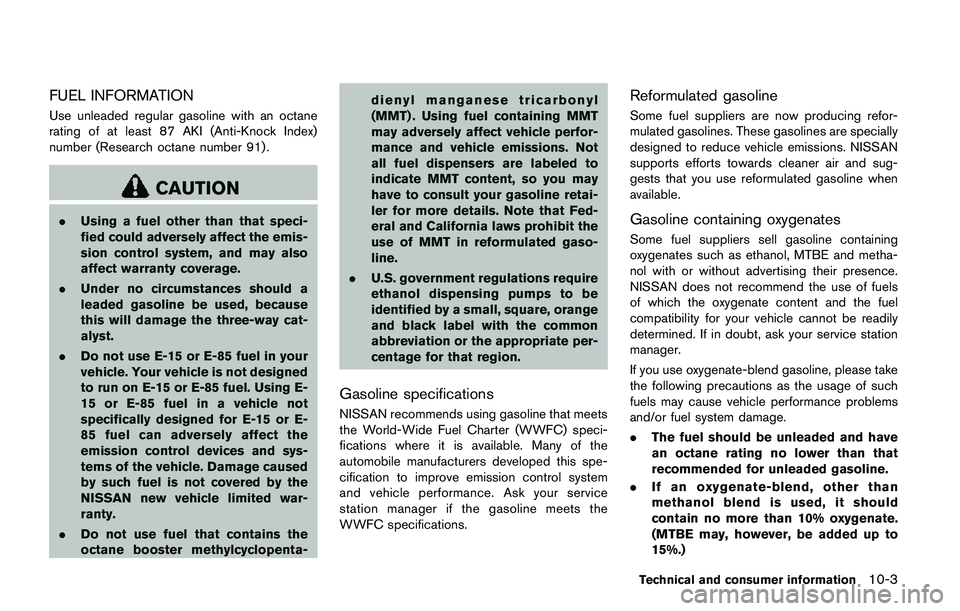
FUEL INFORMATION
Use unleaded regular gasoline with an octane
rating of at least 87 AKI (Anti-Knock Index)
number (Research octane number 91) .
CAUTION
.Using a fuel other than that speci-
fied could adversely affect the emis-
sion control system, and may also
affect warranty coverage.
.Under no circumstances should a
leaded gasoline be used, because
this will damage the three-way cat-
alyst.
.Do not use E-15 or E-85 fuel in your
vehicle. Your vehicle is not designed
to run on E-15 or E-85 fuel. Using E-
15 or E-85 fuel in a vehicle not
specifically designed for E-15 or E-
85 fuel can adversely affect the
emission control devices and sys-
tems of the vehicle. Damage caused
by such fuel is not covered by the
NISSAN new vehicle limited war-
ranty.
.Do not use fuel that contains the
octane booster methylcyclopenta-dienyl manganese tricarbonyl
(MMT) . Using fuel containing MMT
may adversely affect vehicle perfor-
mance and vehicle emissions. Not
all fuel dispensers are labeled to
indicate MMT content, so you may
have to consult your gasoline retai-
ler for more details. Note that Fed-
eral and California laws prohibit the
use of MMT in reformulated gaso-
line.
.U.S. government regulations require
ethanol dispensing pumps to be
identified by a small, square, orange
and black label with the common
abbreviation or the appropriate per-
centage for that region.
Gasoline specifications
NISSAN recommends using gasoline that meets
the World-Wide Fuel Charter (WWFC) speci-
fications where it is available. Many of the
automobile manufacturers developed this spe-
cification to improve emission control system
and vehicle performance. Ask your service
station manager if the gasoline meets the
WWFC specifications.
Reformulated gasoline
Some fuel suppliers are now producing refor-
mulated gasolines. These gasolines are specially
designed to reduce vehicle emissions. NISSAN
supports efforts towards cleaner air and sug-
gests that you use reformulated gasoline when
available.
Gasoline containing oxygenates
Some fuel suppliers sell gasoline containing
oxygenates such as ethanol, MTBE and metha-
nol with or without advertising their presence.
NISSAN does not recommend the use of fuels
of which the oxygenate content and the fuel
compatibility for your vehicle cannot be readily
determined. If in doubt, ask your service station
manager.
If you use oxygenate-blend gasoline, please take
the following precautions as the usage of such
fuels may cause vehicle performance problems
and/or fuel system damage.
.The fuel should be unleaded and have
an octane rating no lower than that
recommended for unleaded gasoline.
.If an oxygenate-blend, other than
methanol blend is used, it should
contain no more than 10% oxygenate.
(MTBE may, however, be added up to
15%.)
Technical and consumer information10-3
Page 483 of 508
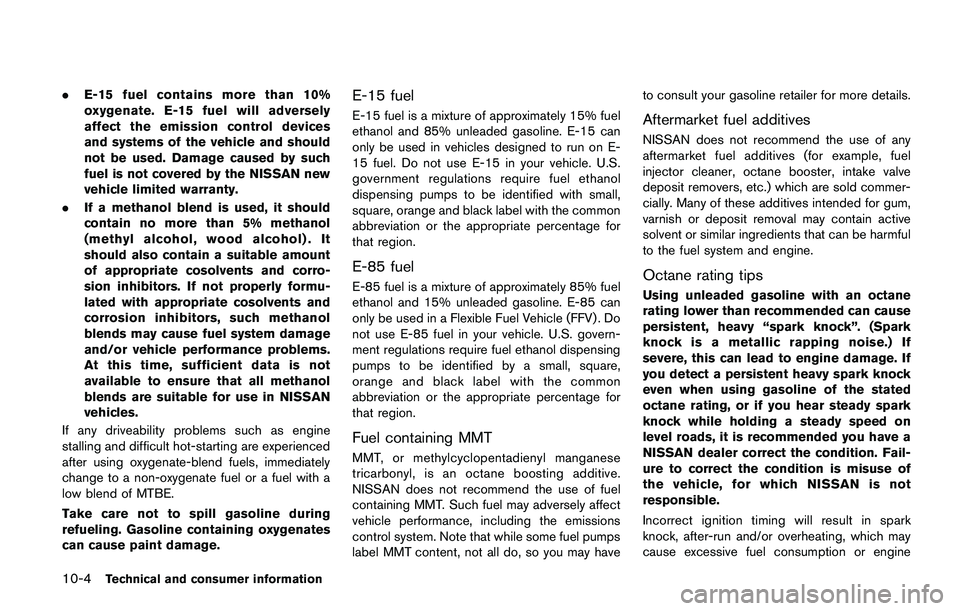
10-4Technical and consumer information
.E-15 fuel contains more than 10%
oxygenate. E-15 fuel will adversely
affect the emission control devices
and systems of the vehicle and should
not be used. Damage caused by such
fuel is not covered by the NISSAN new
vehicle limited warranty.
.If a methanol blend is used, it should
contain no more than 5% methanol
(methyl alcohol, wood alcohol) . It
should also contain a suitable amount
of appropriate cosolvents and corro-
sion inhibitors. If not properly formu-
lated with appropriate cosolvents and
corrosion inhibitors, such methanol
blends may cause fuel system damage
and/or vehicle performance problems.
At this time, sufficient data is not
available to ensure that all methanol
blends are suitable for use in NISSAN
vehicles.
If any driveability problems such as engine
stalling and difficult hot-starting are experienced
after using oxygenate-blend fuels, immediately
change to a non-oxygenate fuel or a fuel with a
low blend of MTBE.
Take care not to spill gasoline during
refueling. Gasoline containing oxygenates
can cause paint damage.E-15 fuel
E-15 fuel is a mixture of approximately 15% fuel
ethanol and 85% unleaded gasoline. E-15 can
only be used in vehicles designed to run on E-
15 fuel. Do not use E-15 in your vehicle. U.S.
government regulations require fuel ethanol
dispensing pumps to be identified with small,
square, orange and black label with the common
abbreviation or the appropriate percentage for
that region.
E-85 fuel
E-85 fuel is a mixture of approximately 85% fuel
ethanol and 15% unleaded gasoline. E-85 can
only be used in a Flexible Fuel Vehicle (FFV) . Do
not use E-85 fuel in your vehicle. U.S. govern-
ment regulations require fuel ethanol dispensing
pumps to be identified by a small, square,
orange and black label with the common
abbreviation or the appropriate percentage for
that region.
Fuel containing MMT
MMT, or methylcyclopentadienyl manganese
tricarbonyl, is an octane boosting additive.
NISSAN does not recommend the use of fuel
containing MMT. Such fuel may adversely affect
vehicle performance, including the emissions
control system. Note that while some fuel pumps
label MMT content, not all do, so you may haveto consult your gasoline retailer for more details.
Aftermarket fuel additives
NISSAN does not recommend the use of any
aftermarket fuel additives (for example, fuel
injector cleaner, octane booster, intake valve
deposit removers, etc.) which are sold commer-
cially. Many of these additives intended for gum,
varnish or deposit removal may contain active
solvent or similar ingredients that can be harmful
to the fuel system and engine.
Octane rating tips
Using unleaded gasoline with an octane
rating lower than recommended can cause
persistent, heavy “spark knock”. (Spark
knock is a metallic rapping noise.) If
severe, this can lead to engine damage. If
you detect a persistent heavy spark knock
even when using gasoline of the stated
octane rating, or if you hear steady spark
knock while holding a steady speed on
level roads, it is recommended you have a
NISSAN dealer correct the condition. Fail-
ure to correct the condition is misuse of
the vehicle, for which NISSAN is not
responsible.
Incorrect ignition timing will result in spark
knock, after-run and/or overheating, which may
cause excessive fuel consumption or engine
Page 487 of 508
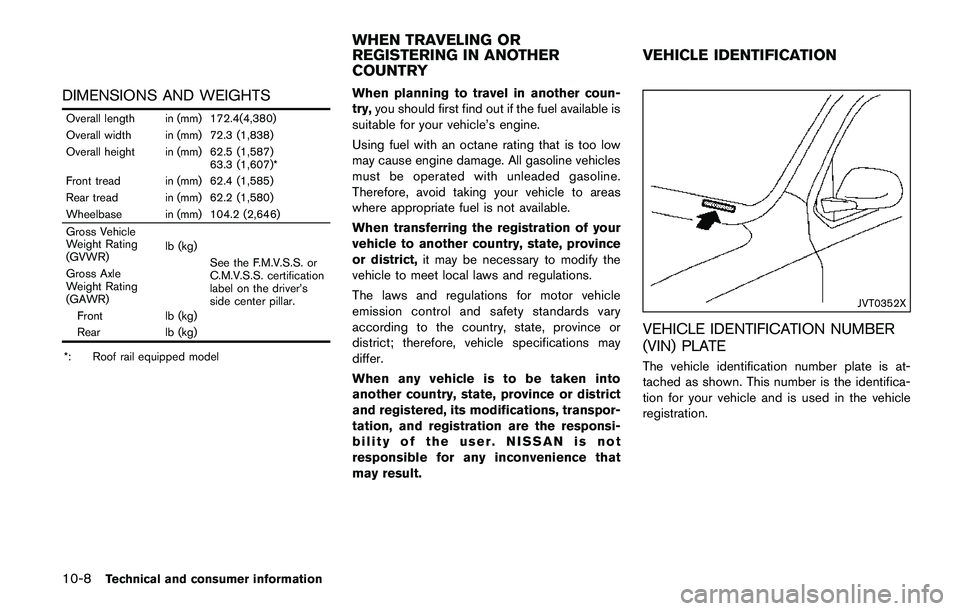
10-8Technical and consumer information
DIMENSIONS AND WEIGHTS
Overall length in (mm) 172.4(4,380)
Overall width in (mm) 72.3 (1,838)
Overall height in (mm) 62.5 (1,587)
63.3 (1,607)*
Front tread in (mm) 62.4 (1,585)
Rear tread in (mm) 62.2 (1,580)
Wheelbase in (mm) 104.2 (2,646)
Gross Vehicle
Weight Rating
(GVWR)lb (kg)
See the F.M.V.S.S. or
C.M.V.S.S. certification
label on the driver’s
side center pillar. Gross Axle
Weight Rating
(GAWR)
Front lb (kg)
Rear lb (kg)
*: Roof rail equipped model
When planning to travel in another coun-
try,you should first find out if the fuel available is
suitable for your vehicle’s engine.
Using fuel with an octane rating that is too low
may cause engine damage. All gasoline vehicles
must be operated with unleaded gasoline.
Therefore, avoid taking your vehicle to areas
where appropriate fuel is not available.
When transferring the registration of your
vehicle to another country, state, province
or district,it may be necessary to modify the
vehicle to meet local laws and regulations.
The laws and regulations for motor vehicle
emission control and safety standards vary
according to the country, state, province or
district; therefore, vehicle specifications may
differ.
When any vehicle is to be taken into
another country, state, province or district
and registered, its modifications, transpor-
tation, and registration are the responsi-
bility of the user. NISSAN is not
responsible for any inconvenience that
may result.
JVT0352X
VEHICLE IDENTIFICATION NUMBER
(VIN) PLATE
The vehicle identification number plate is at-
tached as shown. This number is the identifica-
tion for your vehicle and is used in the vehicle
registration.
WHEN TRAVELING OR
REGISTERING IN ANOTHER
COUNTRYVEHICLE IDENTIFICATION
Page 502 of 508
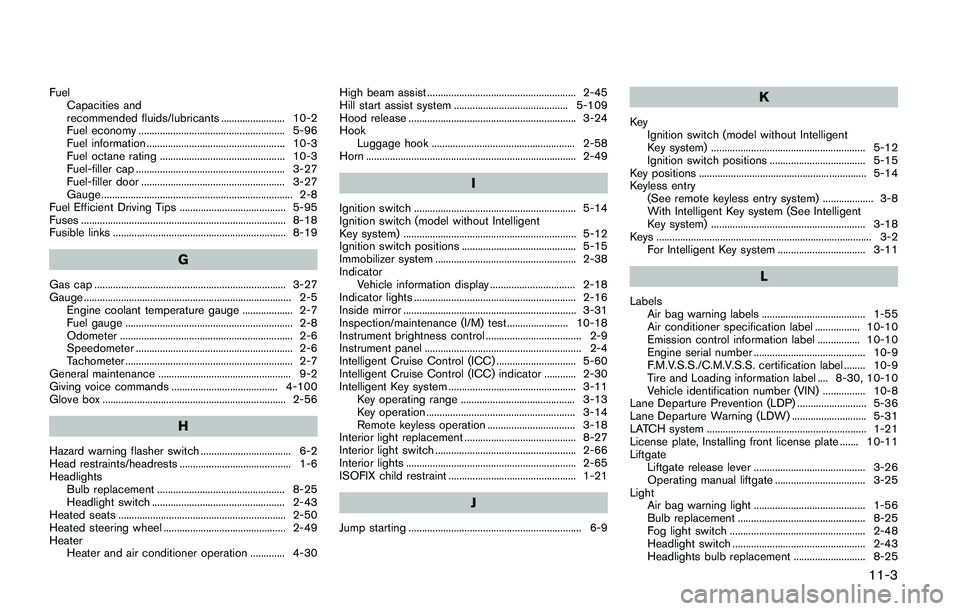
Fuel
Capacities and
recommended fluids/lubricants ........................ 10-2
Fuel economy ....................................................... 5-96
Fuel information .................................................... 10-3
Fuel octane rating ............................................... 10-3
Fuel-filler cap ........................................................ 3-27
Fuel-filler door ...................................................... 3-27
Gauge ........................................................................ 2-8
Fuel Efficient Driving Tips ........................................ 5-95
Fuses ............................................................................. 8-18
Fusible links ................................................................. 8-19
G
Gas cap ........................................................................ 3-27
Gauge .............................................................................. 2-5
Engine coolant temperature gauge ................... 2-7
Fuel gauge ............................................................... 2-8
Odometer ................................................................. 2-6
Speedometer ........................................................... 2-6
Tachometer ............................................................... 2-7
General maintenance .................................................. 9-2
Giving voice commands ........................................ 4-100
Glove box ..................................................................... 2-56
H
Hazard warning flasher switch .................................. 6-2
Head restraints/headrests .......................................... 1-6
Headlights
Bulb replacement ................................................ 8-25
Headlight switch .................................................. 2-43
Heated seats ............................................................... 2-50
Heated steering wheel .............................................. 2-49
Heater
Heater and air conditioner operation ............. 4-30High beam assist ........................................................ 2-45
Hill start assist system ........................................... 5-109
Hood release ............................................................... 3-24
Hook
Luggage hook ...................................................... 2-58
Horn ............................................................................... 2-49
I
Ignition switch ............................................................. 5-14
Ignition switch (model without Intelligent
Key system) ................................................................. 5-12
Ignition switch positions ........................................... 5-15
Immobilizer system ..................................................... 2-38
Indicator
Vehicle information display ................................ 2-18
Indicator lights ............................................................. 2-16
Inside mirror ................................................................. 3-31
Inspection/maintenance (I/M) test ....................... 10-18
Instrument brightness control .................................... 2-9
Instrument panel ........................................................... 2-4
Intelligent Cruise Control (ICC) .............................. 5-60
Intelligent Cruise Control (ICC) indicator ............ 2-30
Intelligent Key system ................................................ 3-11
Key operating range ........................................... 3-13
Key operation ........................................................ 3-14
Remote keyless operation ................................. 3-18
Interior light replacement .......................................... 8-27
Interior light switch ..................................................... 2-66
Interior lights ................................................................ 2-65
ISOFIX child restraint ................................................ 1-21
J
Jump starting ................................................................. 6-9
K
Key
Ignition switch (model without Intelligent
Key system) .......................................................... 5-12
Ignition switch positions .................................... 5-15
Key positions ............................................................... 5-14
Keyless entry
(See remote keyless entry system) ................... 3-8
With Intelligent Key system (See Intelligent
Key system) .......................................................... 3-18
Keys ................................................................................. 3-2
For Intelligent Key system ................................. 3-11
L
Labels
Air bag warning labels ....................................... 1-55
Air conditioner specification label ................. 10-10
Emission control information label ................ 10-10
Engine serial number .......................................... 10-9
F.M.V.S.S./C.M.V.S.S. certification label ........ 10-9
Tire and Loading information label .... 8-30, 10-10
Vehicle identification number (VIN) ................ 10-8
Lane Departure Prevention (LDP) .......................... 5-36
Lane Departure Warning (LDW) ............................ 5-31
LATCH system ............................................................ 1-21
License plate, Installing front license plate ....... 10-11
Liftgate
Liftgate release lever .......................................... 3-26
Operating manual liftgate .................................. 3-25
Light
Air bag warning light .......................................... 1-56
Bulb replacement ................................................ 8-25
Fog light switch ................................................... 2-48
Headlight switch .................................................. 2-43
Headlights bulb replacement ........................... 8-25
11-3
Page 507 of 508
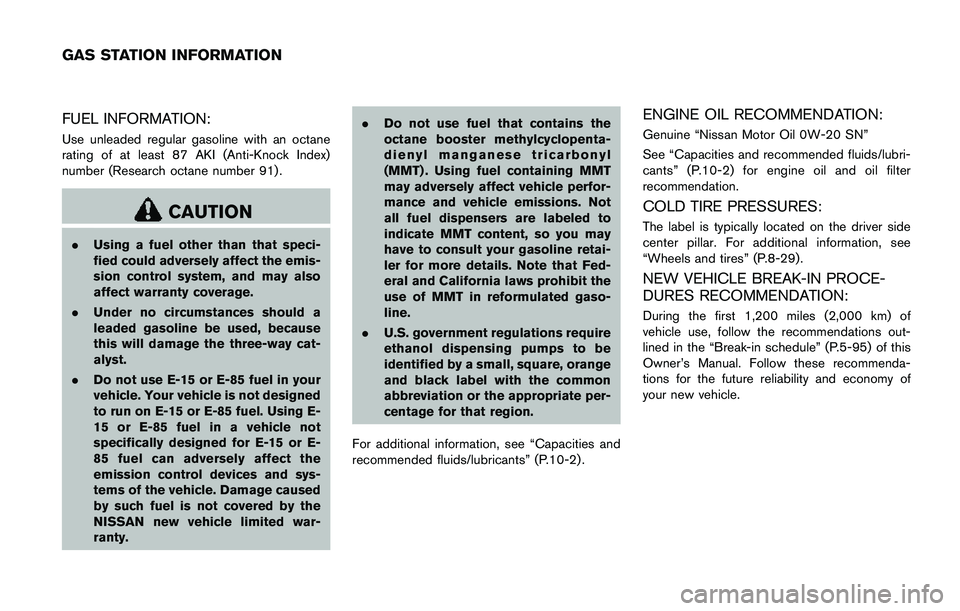
FUEL INFORMATION:
Use unleaded regular gasoline with an octane
rating of at least 87 AKI (Anti-Knock Index)
number (Research octane number 91) .
CAUTION
.Using a fuel other than that speci-
fied could adversely affect the emis-
sion control system, and may also
affect warranty coverage.
.Under no circumstances should a
leaded gasoline be used, because
this will damage the three-way cat-
alyst.
.Do not use E-15 or E-85 fuel in your
vehicle. Your vehicle is not designed
to run on E-15 or E-85 fuel. Using E-
15 or E-85 fuel in a vehicle not
specifically designed for E-15 or E-
85 fuel can adversely affect the
emission control devices and sys-
tems of the vehicle. Damage caused
by such fuel is not covered by the
NISSAN new vehicle limited war-
ranty..Do not use fuel that contains the
octane booster methylcyclopenta-
dienyl manganese tricarbonyl
(MMT) . Using fuel containing MMT
may adversely affect vehicle perfor-
mance and vehicle emissions. Not
all fuel dispensers are labeled to
indicate MMT content, so you may
have to consult your gasoline retai-
ler for more details. Note that Fed-
eral and California laws prohibit the
use of MMT in reformulated gaso-
line.
.U.S. government regulations require
ethanol dispensing pumps to be
identified by a small, square, orange
and black label with the common
abbreviation or the appropriate per-
centage for that region.
For additional information, see “Capacities and
recommended fluids/lubricants” (P.10-2) .
ENGINE OIL RECOMMENDATION:
Genuine “Nissan Motor Oil 0W-20 SN”
See “Capacities and recommended fluids/lubri-
cants” (P.10-2) for engine oil and oil filter
recommendation.
COLD TIRE PRESSURES:
The label is typically located on the driver side
center pillar. For additional information, see
“Wheels and tires” (P.8-29).
NEW VEHICLE BREAK-IN PROCE-
DURES RECOMMENDATION:
During the first 1,200 miles (2,000 km) of
vehicle use, follow the recommendations out-
lined in the “Break-in schedule” (P.5-95) of this
Owner’s Manual. Follow these recommenda-
tions for the future reliability and economy of
your new vehicle.
GAS STATION INFORMATION